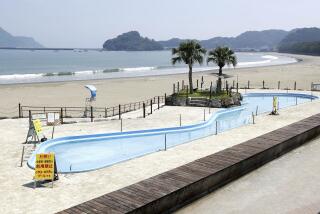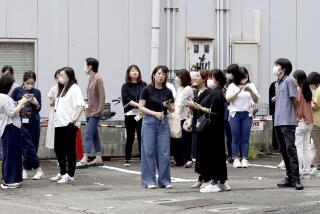Fire erupts again at Fukushima Daiichi’s No. 4 reactor; nuclear fuel rods damaged at other reactors
- Share via
Tokyo — Another fire at Japan’s stricken Fukushima No. 1 (Daiichi) nuclear power complex broke out early Wednesday and authorities said about 70% of another reactor’s fuel rods had been damaged by the spate of accidents and breakdowns since Friday’s earthquake and tsunami.
The ominous disclosure, after authorities insisted throughout the previous day that damage to the overheating reactors was negligible, compounded a sense of escalating hazards and fear five days after the disasters expected to take historic peacetime tolls on Japan’s people and economy.
Plumes of white smoke hung over the Fukushima nuclear complex Wednesday morning, possibly from the plant’s No. 3 reactor. Officials for the Tokyo Electric Power Co. said they did not know the cause of the smoke, but suggested it could be steam.
Photos: Scenes of earthquake destruction
Meanwhile, Japan’s Nuclear and Industrial Safety Agency said an estimated 70% of the nuclear fuel rods have been damaged at the No. 1 reactor and 33% at the No. 2 reactor.
In a sign of how dire the situation has become, authorities had considered using a helicopter to dump water into the No. 4 reactor, which exploded and caught fire Tuesday. The plan was ruled out as too difficult. The company is now weighing a number of options, including using firetrucks to shoot water into the reactor building.
Four firetrucks could be seen heading to the plant Wednesday morning, but it was unclear which reactor they would attend to.
“The biggest problem now isn’t that radiation levels near the building are too high,” said Yuichi Sato, spokesman for the Nuclear and Industrial Safety Agency. “Radiation has fallen to the point where it’s not deemed a risk to human health. It’s all the debris around the reactors that would make it difficult to get a truck close enough.”
The latest blaze thwarting containment efforts broke out in the No. 4 reactor earlier in the day. It was attributed to disaster responders having failed to fully extinguish a fire that struck the same reactor on Tuesday.
The reported partial meltdowns of the No. 1 and No. 2 reactor cores were thought to be responsible for the plume of radiation that escaped Tuesday, sending background radiation levels soaring to degrees that authorities acknowledged were harmful to anyone with prolonged exposure Tuesday.
With the confirmed dead and known missing topping 10,000 and untold thousands of others suspected to still be buried in the sodden wreckage littering the northeast shores of Honshu island, Japan’s mainland, government leaders urged calm and patience as hardships persisted four days after the worst earthquake in Japan’s recorded history.
The devastating tsunami that followed inflicted most of the damage half an hour after Friday’s magnitude 9.0 quake, and a terrifying spate of fires, explosions and missteps at the nuclear power complex in Fukushima prefecture has intensified fears of another calamity.
Radiation released from the six-reactor Fukushima Daiichi complex Tuesday caused a 400-fold increase in background levels outside the stricken plant and about 10 times the normal level in Tokyo, the usually thriving capital 150 miles south of the power facility. Those levels described by a top government official as hazardous to human health declined overnight, suggesting the situation might be stabilizing at the three reactors experiencing cooling problems in the nuclear fuel containment vessels, officials said.
The latest fire, reported by Tokyo Electric Power Co. spokesman Hajimi Motujuku, compounded the woes besetting a skeleton crew of about 70 nuclear plant workers struggling to cool the damaged reactors and avert an uncontrolled release of radiation.
Radiation detected near the plant early Wednesday was insufficient to harm human health, Chief Cabinet Secretary Yukio Edano told reporters. He said the levels had also dropped to about twice the usual level in Tokyo, a negligible level that posed no public hazard, he said.
Any risks posed by the emissions were eased by prevailing winds that carried the steam out to sea rather than over the populated inland, the national meteorological agency noted.
NHK television said 450,000 people remained in makeshift shelters outside the evacuated areas, down by about 100,000 from a day earlier as those made homeless by the earthquake and tsunami began making their way to less-affected areas to stay with relatives and friends.
But authorities still struggled to get food, blankets and other relief to the displaced amid continuing road blockages and idled transport between Japan’s major cities and the hard-hit agricultural and fishing areas of the northeast.
Three new earthquakes with a magnitude greater than 6.0 hit across a wide swath of Honshu on Tuesday, as well as more than a dozen that registered over magnitude 5.0, the U.S. Geological Survey reported.
Search-and-rescue teams from around the world scoured the wreckage of residential areas where the tsunami dumped tons of debris along miles of coastline. But the operations have ground down into a body-retrieval exercise, with only two survivors reported to have been rescued by Tuesday.
The international outpouring of help for Japan brought in a response from 91 nations and at least a dozen multinational relief organizations, the Japanese Foreign Ministry reported. Most were concentrating on devastated Miyagi prefecture, deploying heavy-lifting equipment to pry loose cars, trucks, boats and other objects from the rubble of wood and metal churned and scattered by the tsunami.
In Sendai, the city of 1 million closest to the earthquake’s offshore epicenter, sleet began pelting the ravaged area overnight, a precursor to the snow and falling temperatures forecast for the rest of the week.
As economists began estimating the cost of the disasters, predicting they would exceed those inflicted by Hurricane Katrina in both money and lives, Tokyo’s Nikkei index plummeted for a second day, losing another 10% of its value.
Photos: Scenes of earthquake destruction
More to Read
Sign up for Essential California
The most important California stories and recommendations in your inbox every morning.
You may occasionally receive promotional content from the Los Angeles Times.











